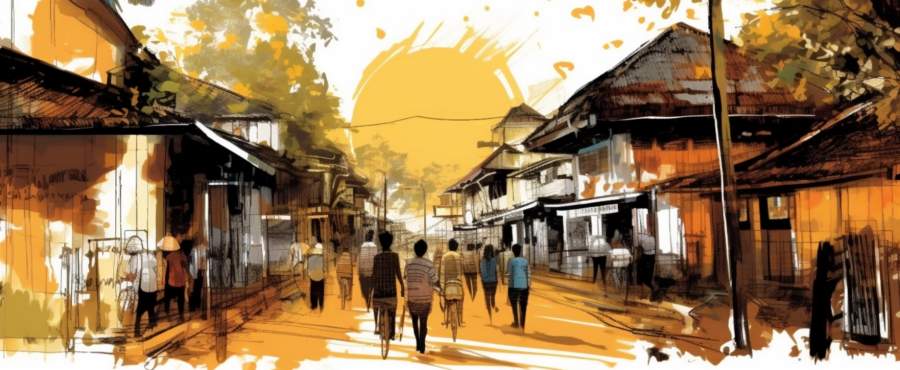A Languid Stroll Through Luang Prabang
 Wading through the viscous humidity that shrouds Luang Prabang is akin to traipsing through an otherworldly dreamscape. Here, the very air seems heavy with centuries of whispered legends, a spectral chorus that adds a touch of the supernatural to the languid Lao life.
Wading through the viscous humidity that shrouds Luang Prabang is akin to traipsing through an otherworldly dreamscape. Here, the very air seems heavy with centuries of whispered legends, a spectral chorus that adds a touch of the supernatural to the languid Lao life.Mount Phou Si, the city's emerald-crowned pate, juts majestically above the rustling palm fronds. Its modest peak is bedecked with glistening stupas, like an elderly monk donning a hat far too flamboyant for his austere lifestyle. And oh, how they sparkle under the indolent sun, a heavenly disco ball thrown in for the deity's afternoon shindig.
Descending from the heights into the city, one navigates a labyrinthine skein of streets, where French colonial and traditional Laotian architecture collide in a haphazard yet charming pas de deux. The edifices, bleached a skeleton white by the sun, stare back at you through timeworn shutters like the blind eyes of ancient seers, their sight lost to time yet knowing all.
Night descends, and the city emerges in a different avatar altogether, the twilit streets a diorama of life and culture. The night market, an Arabian Nights' spectacle doused in electric neon and the carnivalesque chatter of barter, is a flood of color and cacophony. The vendors peddle a gamut of wares, from silken scarves shimmering with the promise of a thousand silkworm dreams to bamboo sticky rice steamers, whose puckered lids echo the knitted brows of the vendors themselves.
However, the true enchantment of Luang Prabang lies neither in its mirthful markets nor its glamorous heights, but rather in the sedate, unhurried flow of the Mekong. This is no Thames, the urban artery throbbing with industrial life. No, this is a river that harks back to a primeval age, its course a leisurely waltz through the verdant canvas of Laotian landscape. Here, time is not measured in minutes but in the languorous drift of the water hyacinth, the river's whimsical flotsam.
With dawn, a peculiar spectacle unfolds: the Tak Bat or alms giving ceremony. An array of monks, swathed in saffron robes, form a solemn procession, a veritable spectral train snaking through the city's arteries at the break of day. The ritualistic clink of the locals dropping sticky rice into the monks' bowls echoes in the morning air, a resonant soundtrack to Luang Prabang's gentle awakening.
The bewitching allure of Luang Prabang lies not in an exhaustive list of attractions or activities. Rather, it resides in the city's ability to instill a sense of temporal disorientation in its visitors. One can't help but feel like a befuddled time traveler, wandering through a chronology that flits, in the blink of an eye, between bygone eras and the modern day.
This city, nestled in the crook of the Mekong's elbow, is a splendid paradox. Luang Prabang balances on the tightrope of time, one foot in the quicksand of modernity and the other anchored in the firm bedrock of tradition. It reminds us, much like a nagging yet wise grandmother, to decelerate our pace, to truly see, smell, taste, and touch the world around us. To experience life not as a race towards the finish line, but as a tranquil drift on the Mekong.
Article kindly provided by myfavouritehols.com
Latest Articles
- How Pro Kitchen Renovations Quietly Increase Booking Confidence in Self-Catering Stays
- Discover a City's Real Character From the Backseat
- How to Make Airport Layovers Surprisingly Productive
- From HVAC to ROI: the Hidden Economics of Sustainable Hotel Design
- How to Plan Your Day Tours to Minimize Crowds and Maximize Serendipity
- From Tourist to Observer: How to Photograph a City Like a Local
- Seasonal Shifts in Abandoned Turkish Valleys Reveal Clues About Heritage Site Decay
- Mastering Group Travel Planning for Events in Fort Lauderdale
- Beyond the Beach Bus: Hidden Palm Beach Spots Worth the Group Ride
- Chrono-Travel and Time Zone Acrobatics on a Coach
- Hidden Miami Charter Bus Routes to Secret Beaches, Local Food Gems, and Underrated Attractions
- More Than Just Ice - Unexpected Events at Amerant Bank Arena
- Madrid's Strangest Museums and Attractions You Never Knew Existed
- Disaster-Proof Rentals: A Flood-Resilient Guide for Holiday Homeowners
- Following the Footsteps of Filmmakers: Morocco's Iconic Movie Locations You Can Visit
- Hidden Gems Along Morocco's Coastline
- Tastes of Miami: Culinary Tours for the Global Foodie
- Milwaukee's Hidden Green Gems: Nature's Best Kept Secrets
- Secret Paths of Peace: Hidden Walking Trails in Disney World
- Vacation Vignettes: Creating Short Travel Films with a Cinematic Touch

